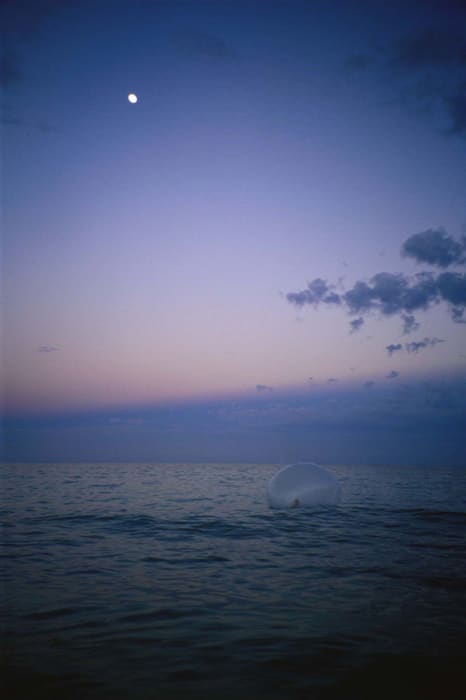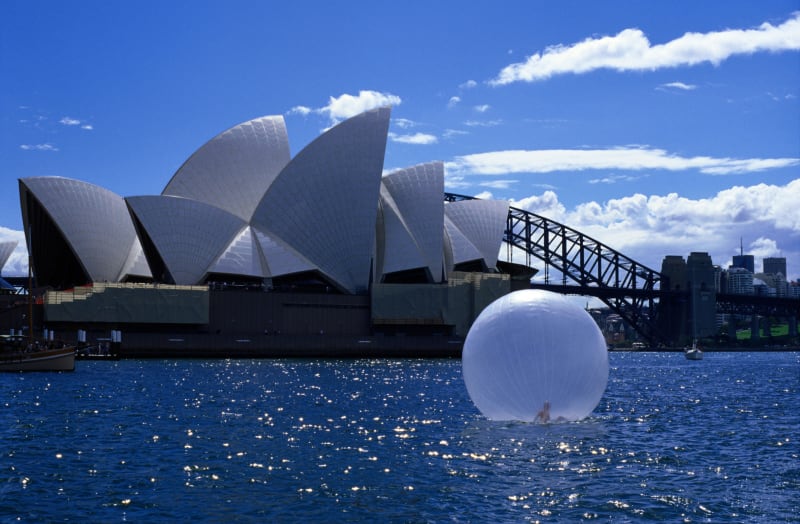Zhu Ming Chinese, b. 1972
"The work of East Village Artist Zhu Ming is equally important in the development of performance art in the 1990s China. In Zhu Ming's performances, his body often forms a zone where the physical and the social meet and collapse."
Thomas J. Berghuis
Born in Hunan Province in 1972 and a Beijing resident since 1993, Zhu Ming gained international recognition with the collective work, "To Add Another Metre to an Anonymous Mountain, in Beijing, 1995". He soon became a leading figure of the East Village, a cradle for the most experimental artists in China. His oeuvre, which deals with theme of vulnerability, is distinguished by great conceptual concision and often restricted to closed environments. The concepts of isolation and vulnerability speak to the explicit and implicit pain that results from both external and internal forces; forces which are socially and intuitionally oppressive, and psychologically driven. The idea of the bubble was derived from Zhu Ming’s experience of washing clothes by hand, a daily practice started when he was nine years old. The foam, made up of clusters of tiny, individual bubbles, nurtured his inspiration.
Performing with a highly symbolic transparent balloon inside of which he immerses himself, his work is infused with various layers of significance. Whether a return to a primordial state, an escape from the rigid social conformity, or a contemporary Vanitas, Zhu Ming's performances have shaped the genre in China for all future generations.
With participations in several pivotal group exhibitions and performances including at the Guggenheim Museum (NYC), the Tate Modern (London), The Victoria & Albert Museum (London), ICP (New York), the Museum of Modern Art (Denmark), etc. Zhu Ming has become one of the most inspiring performer from China. In 2009, he was invited to do one of his bubble performances on the beach for Miami Basel.
-
 Zhu MingLight Space No.26, triptych, 2017
Zhu MingLight Space No.26, triptych, 2017 -
 Zhu MingLight Space No.18, April (Beijing), polyptych, 2015
Zhu MingLight Space No.18, April (Beijing), polyptych, 2015 -
 Zhu Ming12 O’clock, July 1st (Chaidamu, Qinghai), 2014
Zhu Ming12 O’clock, July 1st (Chaidamu, Qinghai), 2014 -
 Zhu Ming13 O'clock, June 30th (Chaidamu, Qinghai), 2014
Zhu Ming13 O'clock, June 30th (Chaidamu, Qinghai), 2014 -
 Zhu Ming15 O'clock July 3rd (Chaidamu, Qinghai), 2014
Zhu Ming15 O'clock July 3rd (Chaidamu, Qinghai), 2014 -
 Zhu Ming15 O'clock, July 1st (Chaidamu, Qinghai), 2014
Zhu Ming15 O'clock, July 1st (Chaidamu, Qinghai), 2014 -
 Zhu Ming15 O'clock, June 30th (Chaidamu, Qinghai), 2014
Zhu Ming15 O'clock, June 30th (Chaidamu, Qinghai), 2014 -
 Zhu Ming16 O'clock, July 2nd (Chaidamu, Qinghai), 2014
Zhu Ming16 O'clock, July 2nd (Chaidamu, Qinghai), 2014 -
 Zhu Ming18 O'clock July 3rd (Chaidamu, Qinghai), 2014
Zhu Ming18 O'clock July 3rd (Chaidamu, Qinghai), 2014 -
 Zhu Ming18 O'clock, July 1st (Chaidamu, Qinghai), 2014
Zhu Ming18 O'clock, July 1st (Chaidamu, Qinghai), 2014 -
 Zhu MingJune 25th (Chaidamu, Qinghai), 2014
Zhu MingJune 25th (Chaidamu, Qinghai), 2014 -
 Zhu Ming10 O’clock, July 27th, NO:A (Sichuan), 2008
Zhu Ming10 O’clock, July 27th, NO:A (Sichuan), 2008 -
 Zhu Ming10 O'clock, July 27th, NoA (Sichuan), 2008
Zhu Ming10 O'clock, July 27th, NoA (Sichuan), 2008 -
 Zhu MingMay 30th, NoA (Jingbian), 2006
Zhu MingMay 30th, NoA (Jingbian), 2006 -
 Zhu MingApril 29th, NoA (Jingxian), 2005
Zhu MingApril 29th, NoA (Jingxian), 2005 -
 Zhu MingDecember 5th, NoA (Miami), 2003
Zhu MingDecember 5th, NoA (Miami), 2003 -
 Zhu MingMarch 9th, NoA (Sydney), 2003
Zhu MingMarch 9th, NoA (Sydney), 2003 -
 Zhu MingMarch 9th, NoB (Sydney), 2003
Zhu MingMarch 9th, NoB (Sydney), 2003 -
 Zhu MingAdd One Meter to an Unknown Mountain (Xijiao, Beijing), 1995
Zhu MingAdd One Meter to an Unknown Mountain (Xijiao, Beijing), 1995
"I hope that through my art, I can convey the relationship between man and nature, that is to say, to explore ideal conditions for an individual to flourish on this planet..."
“The work of East Village Artist, Zhu Ming, is important to the development of performance art in 1990s China. In Zhu Ming's performances, his body often forms a zone where the physical and the social meet and collapse. His work reveal an interaction between the stress and pain imposed on the public body/flesh, and the privately conceived artist's body/self that is internalized through physical endurance and results in the sublation of the body/flesh. This can be seen clearly in the first perfomance Zhu Ming conducted at his studio in the East Village, 3”30 April, 1994”. In the morning, he had constructed an installation made from some of his painting materials, including two wooden frameworks that he had placed together to form a triangle in the center of the room. In the middle, he had hung a small frame, symbolizing the absence of a painted artwork, and running through the installation were a series of twisted plastic tubes. By noon, Zhu Ming tarted the performance in which he spent several hours blowing soap bubbles through tubes, until they filled up the entire room. Throughout this endurance piece, spectators walked in-and-out of the studio, some of whom were art critics who praised the work. Li Xianting photographed the performance, which Zhu Ming had also arranged to have filmed.
Born in 1972 in Changsha, Hunan province, Zhu Ming spent most of his childhood living with his mother and sister. At the time, much of China was still in a state of turmoil because the Cultural Revolution (1966-1976). By early 1971, under the guidance of Zhou Enlai, who aimed at establishing relations with countries such as the United States, China gradually started to consider new economic and institutional reforms. The official end of the Cultural Revolution came within one month after the death of Mao Zedong on 9 September 1976, after the arres of the Gang of Four on 6 October. During his childhood, Zhu Ming often played with other children on the outskirts of Changsha, Because of his small stature, the young Zhu Ming had difficulties standing up for himself. At home, things were not much easier. He recounts how his mother often used a rather strict and occasionally even violent approach to raising her two children, her son in particular. These days, Zhu Ming reflects on these experiences as having been not all bad. Nor, as one migh suspect on seeing his performances for the first time, did these events lead to a long-term trauma, which can be seen as part of these works. The artist's personal experiences and the general social and poslitical context of China after the Cultural Revolution opens a window onto the peace and tranquility behind many of the artist's performances. Two examples of this apparent paradox are his performances “11 am, 14 May 1994” and “1pm, 14 May, 1994” that were staged in Xiaopu Village - a rural village in Songzhuang, east of central Beijing, Tongzhou County.
The first performace was held in a courtyard of a local farm, where Zhu Ming had asked farm workers to bury him alive in mud, after which he spent nearly 2 hours blowing bubbles through a pipe that stuck out from the pile. The entire piece was staged privately, except for the farm workers and one artist friend who captured it on photograph and video. Even watching the video of the perfornance one feels anxious about him being buried for so long, but according to the artist, his body became completely tranquil after going through some initial stress: “ I was capable of transcending the body through a form of meditation by conducting the performance.” The second performance was similar in that it involved a live burial, but this time, the artist lay in a hole next to a graveyard and covered himself in soap-bubbles. Beneath the external rawness that we might imagine in a naked body enduring so much stress, lays a domain where the artist's senses creating the tension are transcended.
In later performances, Zhu Ming began placing himself inside large plastic bubbles. Some viewers believe the bubbles are a metaphor for suffocation, because the artist's body is confined in a small, enclosed space. For Zhu Ming – who curls up in the fetal position during his performances, as if returning to his mother's womb – the bubble becomes a place where reality and illusion exist side by side and where life and death come together.”
Excerpt from Performance Art in China, by Thomas J. Berghuis, TimeZone8, 2006, Pages 105-108

























